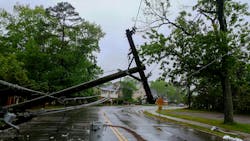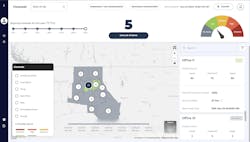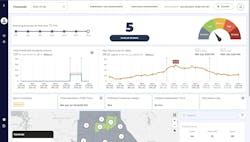Forecasting for Fast, Effective Storm Response
What if there was a way to better understand how storms could impact an electric utility’s service territory 72 hours — three days — in advance?
Avista asked that question as it was experiencing increasingly intense and disruptive storms in its Eastern Washington and Northern Idaho electric service areas, which include regions where it also supplies natural gas. The utility determined that it needed to move beyond basic vegetation management and wildfire mitigation to better predict storms and storm-related incidents and their impacts.
With a model built on a satellite and AI solution for vegetation management, Avista was better able to plan and prepare for each storm — getting the right resources to the right places at the right time.
Forecasting Storms with Satellite Data
Avista had been working with AiDash Intelligent Vegetation Management System (IVMS) since 2021 and was already familiar with the capabilities of satellite and AI technology. IVMS helps to collect imagery of utility infrastructure and vegetation for insights to support mature grid hardening and fire management efforts.
The “lightbulb moment” came when the utility recognized that it could take advantage of satellite imagery of existing vegetation and infrastructure to address storm issues. By merging satellite, historical and forecasted weather data, Avista could create a predictive model capable of providing severe weather and incident forecasts.
Addressing Issues
Before Avista made the move to develop a forecasting system, the utility had to identify major pain points to address to justify the effort. To determine significant issues, the team analyzed customer outage calls and historical performance during past events, reviewed best practices, surveyed 450 residential and business customers and interviewed employees. Major findings included:
- Customers reported slow response to restore power after large storms and lack of communication before, during and after weather events.
- Internally, Avista was relying on individuals to monitor weather and use gut instincts to direct preparation and response. The utility was also depending upon open-source weather forecasting.
With these pain points in mind, the Avista team fleshed out the parameters of what capabilities the outage and incident forecasting tool should provide: - Determine outage risk categories — and assign each of Avista’s 12 offices in the region a risk level for an approaching storm.
- Estimate a range of incidents and customers affected — how the system and customers would be affected within a 72-hour window.
- Send automated notifications to stakeholders when specific triggers are met.
- Determine that minimum thresholds are met — for outage risk, estimated or predicted outages, and estimated or predicted customer impact.
- Provide a “dashboard-like” user interface — allowing stakeholders to view information related to outage forecasting.
- Predict high-level “storm response duration” — estimating how long restoration efforts will take — and provide status, such as “two to three days for Avista to restore all customers,” for example.
Overall, expectations were set to improve customer experience with prediction, planning and response. The forecasting tool would aid efforts by reliably upping channel resources to avoid overwhelming the response team. This would include planning staffing needs for crews and the call center prior to the event hitting the area.
Creating and Testing the Model
Avista worked with AiDash on a pilot that set up a minimal viable product (MVP) “Weather and Incident Forecasting Tool,” to predict storm impact and estimate storm-related incidents within 12 primary office areas in its Eastern Washington and Northern Idaho service regions. The intention was to look at storm predictions at 72, 48, 24, 18, 12 and six hours prior to any storms during the pilot period.
Other goals of the MVP pilot were to:
- Allow for a more significant and consistent window of planning and preparation.
- Remove the need to have a staff member or members monitor weather.
- Reduce the risk that a weather event will be missed or that preparation for it will be insufficient due to staffing, vacation or holiday challenges.
To enable the forecasting tool, the team built an overlay to provide weather information on top of its current satellite and AI solution for vegetation management (IVMS). The system ingested and analyzed satellite imagery, existing infrastructure, new assets and historical storm data as well as the current weather data.
The tool then analyzed results to predict weather and create models of potential customer incidents and outages around 12 regional offices.
By assembling more than 15 years of storm outage data, the pilot program could set storm intensity thresholds. Identifying these thresholds helped the team to evaluate the collective outage risk within the network and in the vicinity of the offices. The effort also enabled a clear view of a storm’s intensity and communicated risk by assigning risk levels to each office area: small, medium, large or extreme.
Severe Weather Testing
Avista tested the proof of concept for storm forecasting in a series of 10 severe weather incidents throughout 2022. The forecasting tool made predictions regarding eight out of the
10 storms, showing 80% accuracy. A look at several storm cases shows increasing benefits from the tool’s capabilities:
Severe Storm Event — November 2022: The tool proved its effectiveness and prediction accuracy when storms punctuated with strong wind gusts hit the area at the beginning of the month. Predicted incidents throughout the storm period showed high accuracy against the 709 actual reported incidents.
With a large sum of the tools’ alerts occurring at least 72 hours ahead of time, Avista had time to assign resources and make sure crews were in place to respond to issues, as well as to notify customers to prepare for an outage, where needed.
The pilot tool’s success in this event prompted Avista to adopt the full AiDash technology behind the tool: AiDash Climate Risk Intelligence System (CRIS).
36-Hour Windstorm — January 2024: Early in the month, Avista’s service area experienced a severe windstorm, which hit some office areas harder than others. The forecasting tool analyzed satellite imagery regarding vegetation data as well as weather reports and noted that the area had experienced five similar storms. It was able to predict that there would be about 163 incidents that would need attention.
The actual total reached 177, which meant the solution delivered 92% accuracy.
Dueling Incidents — Gas Pipeline and Electric Utility — November 2023: One of Avista’s natural gas pipelines was damaged in a serious dig incident. Gas service had to be shut off while the utility deployed large numbers of staff and resources to ensure safety and repair.
As the utility focused on the emergency operations plan (EOP) for the gas line, a storm was building that could threaten electric lines in other locations. While focusing on the EOP, Avista could have missed the approaching severe weather event.
However, the forecasting tool provided advance predictions. With enough early warning, the team could assess resources and divert some to address what turned out to be 50 storm incidents, reducing customer impact.
Improving Efficiency
Outcomes, including predictions and results, have been successfully validated for the Avista and AiDash “Weather and Incident Forecasting Tool” MVP/pilot. The forecasting model was able to predict and capture all storm events and storm related outages across the utility’s network in 2022 with an accuracy of > 80%. And subsequent results reached 92% accuracy.
Features and capabilities of this technology improve its operational efficiencies:
- Monitoring. With the technology monitoring weather, there is no need for Avista to have a dedicated person watching for severe weather 24/7. And with alerts starting 72 hours in advance, the decision-makers have time to consider their options and actions.
- Historical record. The utility can now easily call up the historical record of previous storms with similar criticalities and learn from past restoration efforts to better address current scenarios and reduce restoration times.
- Internal dashboard. Teams throughout Avista, from crew foremen and corporate communications to customer services and account managers, can use the tool’s storm forecasting data for improved planning and preparation in their areas of the business.
- Scope and focus. The model not only assesses the utility’s full territory, but also adds precision to predictions: It identifies specific office regions that will be affected instead of providing only blanket full-grid alerts. Its ability to accelerate forecasting and reporting and to increase advance alert times is proving its effectiveness, storm by storm.
Because more critical storm information is now easily accessible, Avista has experienced improved corporate awareness and better communication across teams. This, in turn, has boosted customer satisfaction, as the utility has been able to alert customers in advance of storms and possible or probable outages, and speed their response to incidents.
As Avista continues to use this technology, which is now implemented in AiDash CRIS, the utility looks forward to reduced costs as well as improvements in both incident response and customer alert time, and, ultimately, in SAIDI and SAIFI.
About the Author
Andrew Barrington
Andrew Barrington ([email protected]) is the products and services manager for Avista. He uses advanced analytics and creative tools, creates and maintains models and onboards new ideas. His competency areas include leadership, product management and change management, and include 10 years of experience in customer success.



